Zoom
Trash

What browsers support HTML5 WebSocket API. Peer-to-Peer Communication Across Network Address Translators. Bryan FordMassachusetts Institute of Technologybaford (at) mit.edu Pyda SrisureshCaymas Systems, Inc.srisuresh (at) yahoo.com Dan Kegeldank (at) kegel.com J'fais des trous, des petits trous toujours des petits trous - S.
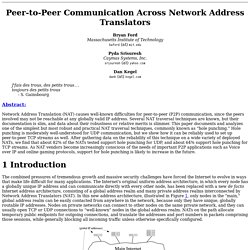
Gainsbourg Abstract: Network Address Translation (NAT) causes well-known difficulties for peer-to-peer (P2P) communication, since the peers involved may not be reachable at any globally valid IP address. The combined pressures of tremendous growth and massive security challenges have forced the Internet to evolve in ways that make life difficult for many applications. The Internet's new de facto address architecture is suitable for client/server communication in the typical case when the client is on a private network and the server is in the global address realm. The WebSocket API. Abstract This specification defines an API that enables Web pages to use the WebSocket protocol (defined by the IETF) for two-way communication with a remote host.
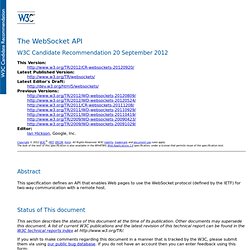
Status of This document This section describes the status of this document at the time of its publication. Other documents may supersede this document. A list of current W3C publications and the latest revision of this technical report can be found in the W3C technical reports index at If you wish to make comments regarding this document in a manner that is tracked by the W3C, please submit them via using our public bug database. You can also e-mail feedback to public-webapps@w3.org (subscribe, archives), or whatwg@whatwg.org (subscribe, archives). Notifications of changes to this specification are sent along with notifications of changes to related specifications using the following mechanisms:
MyGrid. Home. RabbitMQ - Messaging that just works. Getting started with RabbitMQ. Apache Qpid™: Open Source AMQP Messaging. Difference Between Grid Computing and Distributed Computing. Definition of Distributed Computing Distributed Computing is an environment in which a group of independent and geographically dispersed computer systems take part to solve a complex problem, each by solving a part of solution and then combining the result from all computers.
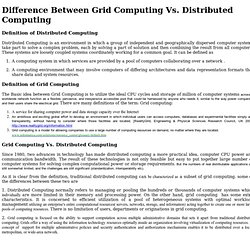
These systems are loosely coupled systems coordinately working for a common goal. It can be defined as A computing system in which services are provided by a pool of computers collaborating over a network .A computing environment that may involve computers of differing architectures and data representation formats that share data and system resources. Definition of Grid Computing The Basic idea between Grid Computing is to utilize the ideal CPU cycles and storage of million of computer systems across a worldwide network function as a flexible, pervasive, and inexpensive accessible pool that could be harnessed by anyone who needs it, similar to the way power companies and their users share the electrical grid. 1. 2.
Grid computing. The use of widely distributed computer resources to reach a common goal Grids are a form of distributed computing whereby a "super virtual computer" is composed of many networked loosely coupled computers acting together to perform large tasks.
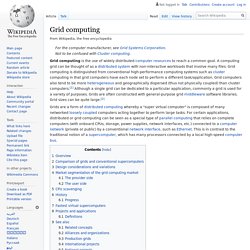
For certain applications, distributed or grid computing can be seen as a special type of parallel computing that relies on complete computers (with onboard CPUs, storage, power supplies, network interfaces, etc.) connected to a computer network (private or public) by a conventional network interface, such as Ethernet. This is in contrast to the traditional notion of a supercomputer, which has many processors connected by a local high-speed computer bus. Overview[edit] Grid computing combines computers from multiple administrative domains to reach a common goal,[3] to solve a single task, and may then disappear just as quickly.
Comparison of grids and conventional supercomputers[edit] Design considerations and variations[edit] The provider side[edit] Distributed computing. "Distributed Information Processing" redirects here.
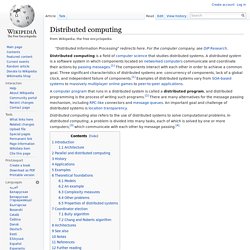
For the computer company, see DIP Research. Apache ActiveMQ ™ Globus. Table - Java CoG Kit. This page contains download information about the Java CoG Kit.
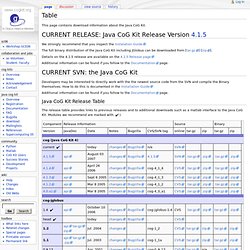
We strongly recommend that you inspect the Instalation Guide. The full binary distribution of the Java CoG Kit including JGlobus can be downloaded from [tar.gz] [zip]. Details on the 4.1.5 release are available on the 4.1.5 Release page Additional information can be found if you follow to the Documentation page. Developers may be interested to directly work with the the newest source code from the SVN and compile the Binary themselves. The release table provides links to previous releases and to additional downloads such as a matlab interface to the Java CoG Kit. Legend:: n/a = not applicable or not available simply get it from CVS as discussed in the Instalation Guide. In-Memory Data Grid - Hazelcast - Home. Multicast. In computer networking, multicast is the delivery of a message or information to a group of destination computers simultaneously in a single transmission from the source.
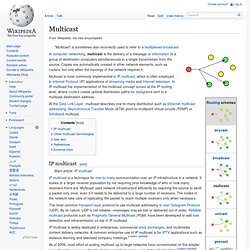
Copies are automatically created in other network elements, such as routers, but only when the topology of the network requires it. Osiris (Serverless Portal System) Osiris Serverless Portal System (usually abbreviated as Osiris sps or Osiris) is a freeware program used to create web portals distributed via peer-to-peer networking (P2P) and autonomous from centralized servers.
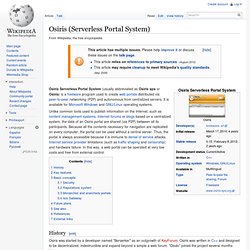
It is available for Microsoft Windows and GNU/Linux operating systems. Unlike common tools used to publish information on the Internet, such as content management systems, Internet forums or blogs based on a centralized system, the data of an Osiris portal are shared (via P2P) between all its participants. Because all the contents necessary for navigation are replicated on every computer, the portal can be used without a central server. Thus, the portal is always accessible because it is immune to denial of service attacks, Internet service provider limitations (such as traffic shaping and censorship) and hardware failure. In this way, a web portal can be operated at very low costs and free from external control.